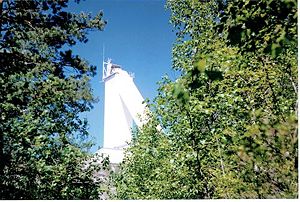Institute of Solar-Terrestrial Physics of Siberian Branch of Russian Academy of Sciences (ISTP SB RAS)
Large Solar Vacuum Telescope
From ISTP SB RAS
 | LSVT was constructed in 1980. It provides spectropolarimetric observations in visible light and infra-red spectrum.
The unique features of the LSVT optical system allow us to obtain high-quality solar spectra and spectroheliograms which are needful to study fine structure of the solar atmosphere. Solar flare mechanism is the main line of investigation by means of LSVT. According to modern ideas, transfer of energy from the corona to chromosphere generates an optical flare. There are different mechanisms of energy transfer: heat conductivity, beams of protons or electrons, x-ray radiation. Spectropolarimetric studies at LSVT indicate the presence of linear polarization in solar flares. High-energy particle beams are proved to bombard the chromosphere during solar flares. Research conducted at LSVT serve as the basis for designing the next-generation solar telescopes. We have been developing the adaptive optics system for LSVT together with scientists from the Institute of Atmospheric Optics (Tomsk). Systems with adaptive optics are employed to improve quality of images and correct image distortions caused by thermal and atmospheric phenomena. |
[edit] Equipment
 | LSVT is a catadioptric optical system. The polar heliostat with a flat mirror of 1 m in diameter is installed at the top of 25-meter vertical column. The heliostat reflects sunlight along the polar axis towards the doublet lens with the diameter of 760 mm and the focal length of 40 m. The LSVT spatial resolution (0.2 arcsec) corresponds to that of the world’s best solar telescopes. |
 | The LSVT tube is encased in a protective case and is inclined at an angle of 52° to the horizon. Vacuum is created inside the tube to eliminate effect of air density fluctuations on quality of images. Spectrograph comprises three mirrors and a diffraction grating of 200x300 mm2. Being equipped with linear and circular polarization analysers, the spectrograph allows us to achieve the spectral resolution of 0.0007 nm. Apart from LSVT, BAO also comprises three chromospheric telescopes for making regular observations of the solar chromosphere and for recording non-stationary events in the solar atmosphere. Telescopes provide solar images in H-alpha and ionized calcium CaII lines. Chromospheric structure of CaII line demonstrates strong and moderate magnetic fields on the Sun’s surface. Observational results from LSVT and complex of chromospheric telescopes gave a better understanding to the physics of solar flares and enabled us to find new regularities of large-scale distribution of solar activity. Geo-effective solar flares were shown to occur in the regions with long-term activity. A strategy for forecasting these flares was developed. |
 | The TEK 512×512 CCD camera is used to obtain spectrograms and spectropolarograms. Using the H-alpha birefringent filter (BF) and another CCD camera placed on the optical bench, simultaneous observations are made in the light reflected from the mirror slit. The CCD camera allows us to obtain real-time images of the Sun or spectrum. |
- This page has been accessed 15,953 times.
